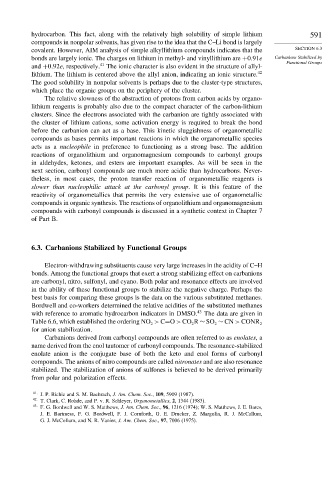Page 609 - Advanced Organic Chemistry Part A - Structure and Mechanisms, 5th ed (2007) - Carey _ Sundberg
P. 609
hydrocarbon. This fact, along with the relatively high solubility of simple lithium 591
compounds in nonpolar solvents, has given rise to the idea that the C–Li bond is largely
covalent. However, AIM analysis of simple alkyllithium compounds indicates that the SECTION 6.3
bonds are largely ionic. The charges on lithium in methyl- and vinyllithium are +0 91e Carbanions Stabilized by
Functional Groups
41
and +0 92e, respectively. The ionic character is also evident in the structure of allyl-
lithium. The lithium is centered above the allyl anion, indicating an ionic structure. 42
The good solubility in nonpolar solvents is perhaps due to the cluster-type structures,
which place the organic groups on the periphery of the cluster.
The relative slowness of the abstraction of protons from carbon acids by organo-
lithium reagents is probably also due to the compact character of the carbon-lithium
clusters. Since the electrons associated with the carbanion are tightly associated with
the cluster of lithium cations, some activation energy is required to break the bond
before the carbanion can act as a base. This kinetic sluggishness of organometallic
compounds as bases permits important reactions in which the organometallic species
acts as a nucleophile in preference to functioning as a strong base. The addition
reactions of organolithium and organomagnesium compounds to carbonyl groups
in aldehydes, ketones, and esters are important examples. As will be seen in the
next section, carbonyl compounds are much more acidic than hydrocarbons. Never-
theless, in most cases, the proton transfer reaction of organometallic reagents is
slower than nucleophilic attack at the carbonyl group. It is this feature of the
reactivity of organometallics that permits the very extensive use of organometallic
compounds in organic synthesis. The reactions of organolithium and organomagnesium
compounds with carbonyl compounds is discussed in a synthetic context in Chapter 7
of Part B.
6.3. Carbanions Stabilized by Functional Groups
Electron-withdrawing substituents cause very large increases in the acidity of C–H
bonds. Among the functional groups that exert a strong stabilizing effect on carbanions
are carbonyl, nitro, sulfonyl, and cyano. Both polar and resonance effects are involved
in the ability of these functional groups to stabilize the negative charge. Perhaps the
best basis for comparing these groups is the data on the various substituted methanes.
Bordwell and co-workers determined the relative acidities of the substituted methanes
with reference to aromatic hydrocarbon indicators in DMSO. 43 The data are given in
Table 6.6, which established the ordering NO > C=O > CO R ∼ SO ∼ CN > CONR
2 2 2 2
for anion stabilization.
Carbanions derived from carbonyl compounds are often referred to as enolates,a
name derived from the enol tautomer of carbonyl compounds. The resonance-stabilized
enolate anion is the conjugate base of both the keto and enol forms of carbonyl
compounds. The anions of nitro compounds are called nitronates and are also resonance
stabilized. The stabilization of anions of sulfones is believed to be derived primarily
from polar and polarization effects.
41
J. P. Richie and S. M. Bachrach, J. Am. Chem. Soc., 109, 5909 (1987).
42 T. Clark, C. Rohde, and P. v. R. Schleyer, Organometallics, 2, 1344 (1983).
43
F. G. Bordwell and W. S. Matthews, J. Am. Chem. Soc., 96, 1216 (1974); W. S. Matthews, J. E. Bares,
J. E. Bartmess, F. G. Bordwell, F. J. Cornforth, G. E. Drucker, Z. Margolin, R. J. McCallum,
G. J. McCollum, and N. R. Vanier, J. Am. Chem. Soc., 97, 7006 (1975).

